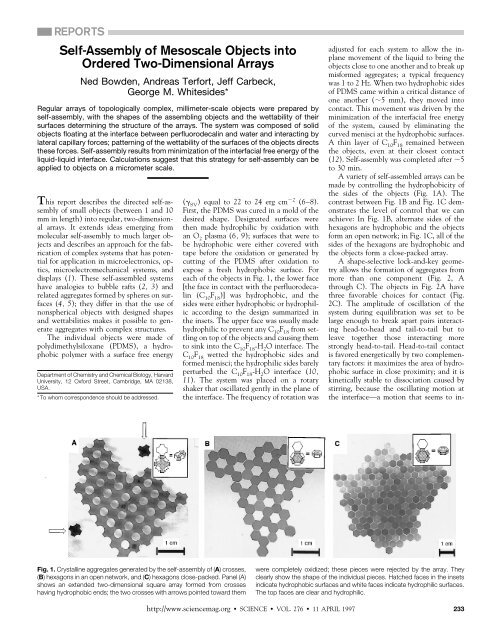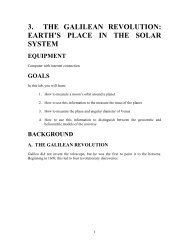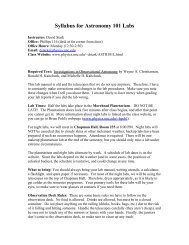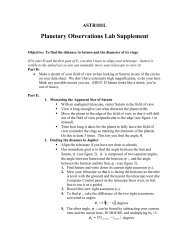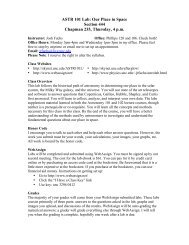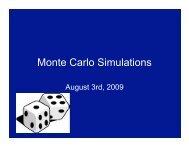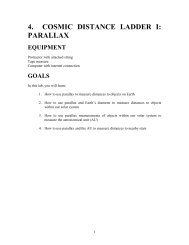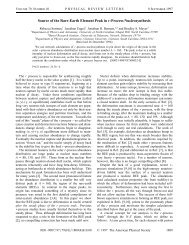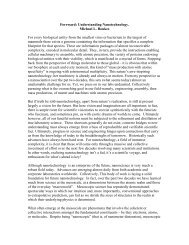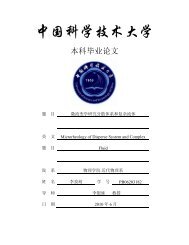Self-Assembly of Mesoscale Objects into Ordered Two-Dimensional ...
Self-Assembly of Mesoscale Objects into Ordered Two-Dimensional ...
Self-Assembly of Mesoscale Objects into Ordered Two-Dimensional ...
You also want an ePaper? Increase the reach of your titles
YUMPU automatically turns print PDFs into web optimized ePapers that Google loves.
REPORTS<br />
<strong>Self</strong>-<strong>Assembly</strong> <strong>of</strong> <strong>Mesoscale</strong> <strong>Objects</strong> <strong>into</strong><br />
<strong>Ordered</strong> <strong>Two</strong>-<strong>Dimensional</strong> Arrays<br />
Ned Bowden, Andreas Terfort, Jeff Carbeck,<br />
George M. Whitesides*<br />
Regular arrays <strong>of</strong> topologically complex, millimeter-scale objects were prepared by<br />
self-assembly, with the shapes <strong>of</strong> the assembling objects and the wettability <strong>of</strong> their<br />
surfaces determining the structure <strong>of</strong> the arrays. The system was composed <strong>of</strong> solid<br />
objects floating at the interface between perfluorodecalin and water and interacting by<br />
lateral capillary forces; patterning <strong>of</strong> the wettability <strong>of</strong> the surfaces <strong>of</strong> the objects directs<br />
these forces. <strong>Self</strong>-assembly results from minimization <strong>of</strong> the interfacial free energy <strong>of</strong> the<br />
liquid-liquid interface. Calculations suggest that this strategy for self-assembly can be<br />
applied to objects on a micrometer scale.<br />
This report describes the directed self-assembly<br />
<strong>of</strong> small objects (between 1 and 10<br />
mm in length) <strong>into</strong> regular, two-dimensional<br />
arrays. It extends ideas emerging from<br />
molecular self-assembly to much larger objects<br />
and describes an approach for the fabrication<br />
<strong>of</strong> complex systems that has potential<br />
for application in microelectronics, optics,<br />
microelectromechanical systems, and<br />
displays (1). These self-assembled systems<br />
have analogies to bubble rafts (2, 3) and<br />
related aggregates formed by spheres on surfaces<br />
(4, 5); they differ in that the use <strong>of</strong><br />
nonspherical objects with designed shapes<br />
and wettabilities makes it possible to generate<br />
aggregates with complex structures.<br />
The individual objects were made <strong>of</strong><br />
polydimethylsiloxane (PDMS), a hydrophobic<br />
polymer with a surface free energy<br />
Department <strong>of</strong> Chemistry and Chemical Biology, Harvard<br />
University, 12 Oxford Street, Cambridge, MA 02138,<br />
USA.<br />
*To whom correspondence should be addressed.<br />
( SV<br />
) equal to 22 to 24 erg cm 2 (6–8).<br />
First, the PDMS was cured in a mold <strong>of</strong> the<br />
desired shape. Designated surfaces were<br />
then made hydrophilic by oxidation with<br />
an O 2<br />
plasma (6, 9); surfaces that were to<br />
be hydrophobic were either covered with<br />
tape before the oxidation or generated by<br />
cutting <strong>of</strong> the PDMS after oxidation to<br />
expose a fresh hydrophobic surface. For<br />
each <strong>of</strong> the objects in Fig. 1, the lower face<br />
[the face in contact with the perfluorodecalin<br />
(C 10<br />
F 18<br />
)] was hydrophobic, and the<br />
sides were either hydrophobic or hydrophilic<br />
according to the design summarized in<br />
the insets. The upper face was usually made<br />
hydrophilic to prevent any C 10<br />
F 18<br />
from settling<br />
on top <strong>of</strong> the objects and causing them<br />
to sink <strong>into</strong> the C 10<br />
F 18<br />
-H 2<br />
O interface. The<br />
C 10<br />
F 18<br />
wetted the hydrophobic sides and<br />
formed menisci; the hydrophilic sides barely<br />
perturbed the C 10<br />
F 18<br />
-H 2<br />
O interface (10,<br />
11). The system was placed on a rotary<br />
shaker that oscillated gently in the plane <strong>of</strong><br />
the interface. The frequency <strong>of</strong> rotation was<br />
adjusted for each system to allow the inplane<br />
movement <strong>of</strong> the liquid to bring the<br />
objects close to one another and to break up<br />
misformed aggregates; a typical frequency<br />
was 1 to 2 Hz. When two hydrophobic sides<br />
<strong>of</strong> PDMS came within a critical distance <strong>of</strong><br />
one another (5 mm), they moved <strong>into</strong><br />
contact. This movement was driven by the<br />
minimization <strong>of</strong> the interfacial free energy<br />
<strong>of</strong> the system, caused by eliminating the<br />
curved menisci at the hydrophobic surfaces.<br />
A thin layer <strong>of</strong> C 10<br />
F 18<br />
remained between<br />
the objects, even at their closest contact<br />
(12). <strong>Self</strong>-assembly was completed after 5<br />
to 30 min.<br />
A variety <strong>of</strong> self-assembled arrays can be<br />
made by controlling the hydrophobicity <strong>of</strong><br />
the sides <strong>of</strong> the objects (Fig. 1A). The<br />
contrast between Fig. 1B and Fig. 1C demonstrates<br />
the level <strong>of</strong> control that we can<br />
achieve: In Fig. 1B, alternate sides <strong>of</strong> the<br />
hexagons are hydrophobic and the objects<br />
form an open network; in Fig. 1C, all <strong>of</strong> the<br />
sides <strong>of</strong> the hexagons are hydrophobic and<br />
the objects form a close-packed array.<br />
A shape-selective lock-and-key geometry<br />
allows the formation <strong>of</strong> aggregates from<br />
more than one component (Fig. 2, A<br />
through C). The objects in Fig. 2A have<br />
three favorable choices for contact (Fig.<br />
2C). The amplitude <strong>of</strong> oscillation <strong>of</strong> the<br />
system during equilibration was set to be<br />
large enough to break apart pairs interacting<br />
head-to-head and tail-to-tail but to<br />
leave together those interacting more<br />
strongly head-to-tail. Head-to-tail contact<br />
is favored energetically by two complementary<br />
factors: it maximizes the area <strong>of</strong> hydrophobic<br />
surface in close proximity; and it is<br />
kinetically stable to dissociation caused by<br />
stirring, because the oscillating motion at<br />
the interface—a motion that seems to in-<br />
Fig. 1. Crystalline aggregates generated by the self-assembly <strong>of</strong> (A) crosses,<br />
(B) hexagons in an open network, and (C) hexagons close-packed. Panel (A)<br />
shows an extended two-dimensional square array formed from crosses<br />
having hydrophobic ends; the two crosses with arrows pointed toward them<br />
were completely oxidized; these pieces were rejected by the array. They<br />
clearly show the shape <strong>of</strong> the individual pieces. Hatched faces in the insets<br />
indicate hydrophobic surfaces and white faces indicate hydrophilic surfaces.<br />
The top faces are clear and hydrophilic.<br />
http://www.sciencemag.org SCIENCE VOL. 276 11 APRIL 1997 233
fluence the objects primarily by shear—has<br />
minimal influence on pairs <strong>of</strong> objects once<br />
assembled <strong>into</strong> a head-to-tail configuration.<br />
A third method for self-assembly uses<br />
the area <strong>of</strong> hydrophobic side surfaces, and<br />
thus the strength <strong>of</strong> the attractive capillary<br />
force, to direct the self-assembly <strong>of</strong> different<br />
objects (Fig. 3, A through D). A mixture <strong>of</strong><br />
two types <strong>of</strong> PDMS objects with the same<br />
square bases, but heights that differed by a<br />
factor <strong>of</strong> 5, were agitated at the interface<br />
between C 10 F 18 and water. The order <strong>of</strong> the<br />
attractive forces in the system was talltall<br />
tall-short short-short. The degree<br />
<strong>of</strong> agitation was set to allow the tall objects<br />
to form an array; when agitation was<br />
Fig. 2. Lock-and-key self-assembly. Lines are<br />
formed from one type <strong>of</strong> component (A) and from<br />
two different types <strong>of</strong> components (B). (C) The<br />
three possibilities for favorable assembly <strong>of</strong> two<br />
objects in (A). Although in the tail-to-tail arrangement<br />
in (C) no hydrophobic surfaces are in contact,<br />
this interaction was observed to be important<br />
because the menisci are brought close enough<br />
together to interact. Dark faces in the insets in (A) and (B) indicate hydrophobic sides and white faces<br />
indicate hydrophilic sides. The top faces are clear and hydrophilic.<br />
stopped, the short objects coagulated<br />
around this array in a disordered state.<br />
The above experiments were carried out<br />
with objects having dimensions <strong>of</strong> 1 to 10<br />
mm. We investigated the lower limits to the<br />
size <strong>of</strong> the objects that could be assembled<br />
by lateral capillary forces at the C 10 F 18 -H 2 O<br />
interface by calculating the change in interfacial<br />
free energy as two perpendicular<br />
surfaces moved from infinite separation to<br />
some finite separation, d. We calculated the<br />
height h (in meters) <strong>of</strong> the C 10 F 18 -H 2 O<br />
interface between the two objects using the<br />
linearized Laplace equation (13) (Fig. 4A)<br />
2 h<br />
x 2 1 gh P 0 (1)<br />
where (in joules per square meter) is the<br />
interfacial free energy, (in kilograms per<br />
cubic meter) is the difference in density<br />
between the two fluids, the zero for h is set<br />
at the C 10 F 18 -H 2 O interface far from the<br />
objects, g (in meters per second per second)<br />
is the acceleration due to gravity, and P 0<br />
(in pascals) is the change in pressure across<br />
the interface at x 0. If we assign a value<br />
<strong>of</strong> h(0) 0, then the value <strong>of</strong> P 0 does not<br />
enter <strong>into</strong> the solution <strong>of</strong> Eq. 1. Using the<br />
boundary conditions h(r) t, where t (in<br />
meters) is the thickness <strong>of</strong> the object and<br />
(h/x) x0 0, we find that the solution <strong>of</strong><br />
Eq.1is<br />
2<br />
hxt ex/xc d/2xc e x/xc)<br />
1e d/xc e d/2xc (2)<br />
e<br />
Fig. 3. <strong>Self</strong>-assembly based on different heights. The<br />
two components are identical except for their heights,<br />
and their sides are hydrophobic. The light gray objects<br />
in (A) and (B) have a height <strong>of</strong> 2.5 mm and the<br />
dark gray objects have a height <strong>of</strong> 0.5 mm. In (A) the<br />
objects have just begun to assemble. After 20 min<br />
<strong>of</strong> agitation, the objects in (B) have segregated <strong>into</strong><br />
two regions: a crystalline central array <strong>of</strong> the taller<br />
objects, surrounded by a disordered collection <strong>of</strong> the<br />
smaller ones. (C) A schematic view <strong>of</strong> the interaction <strong>of</strong> the objects <strong>of</strong> different heights. (D) Side view <strong>of</strong><br />
the three different interactions when two pieces <strong>of</strong> PDMS with different heights are assembled. The<br />
strength <strong>of</strong> interaction increases from right to left.<br />
Fig. 4. (A) The coordinate system for Eqs. 1 and 2.<br />
The objects have a height <strong>of</strong> t and a width <strong>of</strong> w <br />
5t , and their proximate surfaces are separated by<br />
d. (B) The logarithm <strong>of</strong> the change in interfacial<br />
free energy—divided by thermal energy, kT—in<br />
bringing two surfaces from infinite separation to a<br />
finite separation, d, is plotted for heights from t <br />
1 mm to 100 nm.<br />
234<br />
SCIENCE VOL. 276 11 APRIL 1997 http://www.sciencemag.org
REPORTS<br />
where we have made the replacement x c <br />
(/g) 1/2 . For infinite d the capillary surface<br />
is given by a simple exponential decay<br />
with h(x) e (x/x c) .<br />
To estimate the change in interfacial<br />
energy as a function <strong>of</strong> distance, we calculated<br />
the difference in the arc length (in<br />
meters), defined by h(x) for two surfaces<br />
separated by d and two surfaces separated by<br />
an infinite distance; the change in arc<br />
length was then multiplied by the width <strong>of</strong><br />
the object w (in meters), and the interfacial<br />
free energy to yield the change in interfacial<br />
free energy (14). As a model system, we<br />
assigned a length to the perpendicular surface<br />
equal to five times the height. This<br />
model gave a change in interfacial free energy,<br />
W, <strong>of</strong> W 5t. From the<br />
change in interfacial free energy for heights<br />
from t 1 mm to 100 nm (Fig. 4B), we<br />
conclude that the energetics for self-assembly<br />
are favorable for objects with t as small<br />
as 100 nm. For the two-dimensional selfassembly<br />
<strong>of</strong> spheres, the radius at which<br />
W/kT 1 (where kT is the thermal energy)<br />
has been calculated to be on the order<br />
<strong>of</strong> 1 to 10 m (15, 16). <strong>Self</strong>-assembly<br />
driven by capillary forces between conformal<br />
surfaces should therefore make possible<br />
the assembly <strong>of</strong> much smaller objects<br />
than would be possible with spheres; the<br />
ability to control the shapes and interfacial<br />
properties <strong>of</strong> these objects makes it<br />
possible to design the geometries <strong>of</strong> the<br />
resulting arrays.<br />
Four factors contribute to the success <strong>of</strong><br />
this strategy for the directed self-assembly <strong>of</strong><br />
small objects. First, the aggregates are energetically<br />
more stable than the individual<br />
dissociated objects or disordered aggregates.<br />
Second, formation <strong>of</strong> the aggregates is reversible<br />
when the system is agitated: formation<br />
and dissociation <strong>of</strong> the aggregates compete.<br />
The aggregates are therefore able to<br />
reach the energetically most stable form.<br />
Third, the hydrophobic sides are attracted<br />
to one another over large distances (about<br />
two to three times the dimension <strong>of</strong> the<br />
height), leading to relatively rapid assembly.<br />
Fourth, even when two hydrophobic<br />
sides are in close proximity, they can move<br />
laterally from side to side, lubricated by the<br />
intervening film <strong>of</strong> C 10<br />
F 18<br />
, and can thus<br />
maximize the amount <strong>of</strong> hydrophobic area<br />
in contact.<br />
REFERENCES AND NOTES<br />
___________________________<br />
1. There are few methods for assembling arrays <strong>of</strong><br />
small objects. See (2, 4, 5); J. K. Tu, J. J. Talghader,<br />
M. A. Hadley, J. S. Smith, Electron. Lett. 31, 1448<br />
(1995); A. Ashkin and J. M. Dziedzic, Science 235,<br />
1517 (1987); K. Svoboda and S. M. Block, Annu.<br />
Rev. Biophys. Biomol. Struct. 23, 247 (1994).<br />
2. A. W. Simpson and P. H. Hodkinson, Nature 237,<br />
320 (1972).<br />
3. S. T. Schober, J. Friedrich, A. Altmann, J. Appl.<br />
Phys. 71, 2206 (1992).<br />
4. M. Yamaki, J. Higo, K. Nagayama, Langmuir 11,<br />
2975 (1995).<br />
5. P. A. Kralchevsky and K. Nagayama, ibid. 10, 23<br />
(1994).<br />
6. PDMS is easy to fabricate and its solid-liquid interfacial<br />
free energy can be readily controlled by oxidation to<br />
make the surfaces hydrophilic or hydrophobic. We<br />
placed the PDMS structure <strong>into</strong> a plasma cleaner for 5<br />
min under O 2<br />
at a pressure <strong>of</strong> 0.20 torr to oxidize the<br />
PDMS. The oxidation <strong>of</strong> PDMS is believed to result in<br />
a surface that comprises SiOH groups. The contact<br />
angle <strong>of</strong> water on oxidized PDMS is less than 15°.<br />
7. M. J. Owen, J. Coatings Technol. 53, 49 (1981).<br />
8. W. A. Zisman, in Symposium on Adhesion and Cohesion,<br />
P. Weiss, Ed. (Elsevier, New York, 1962), p.<br />
176.<br />
9. D. W. Fakes, M. C. Davies, A. Browns, J. M. Newton,<br />
Surf. Interface Anal. 13, 233 (1988).<br />
10. The perfluorodecalin wet the unoxidized PDMS and<br />
formed a meniscus; the water wet the higher energy<br />
surface <strong>of</strong> oxidized PDMS. The capillary forces acting<br />
at the oxidized surfaces were very weakly attractive<br />
compared to those <strong>of</strong> the hydrophobic surfaces,<br />
because the PDMS (density 1.05 g ml 1 ) does not<br />
sink far enough <strong>into</strong> the perfluorodecalin (density <br />
1.91 g ml 1 ) to generate a meniscus with significant<br />
curvature at the hydrophilic interfaces. Other fluorinated<br />
alkanes with properties similar to those <strong>of</strong> perfluorodecalin<br />
were used with equal success.<br />
11. C. D. Dashkin, P. A. Kralchevsky, W. N. Paunov, H.<br />
Yoshimura, K. Nagayama, Langmuir 12, 641 (1996).<br />
12. The evidence that a thin layer <strong>of</strong> C 10<br />
F 18<br />
remained<br />
between the PDMS solids at their closest contact is<br />
indirect: When two flat pieces <strong>of</strong> PDMS come in<br />
contact in water with no C 10<br />
F 18<br />
present, they stick to<br />
each other strongly, and this process is effectively<br />
irreversible. If we add C 10<br />
F 18<br />
to the water after the<br />
PDMS solids have come <strong>into</strong> contact, they remain<br />
stuck to one another.<br />
13. H. T. Davis, Statistical Mechanics <strong>of</strong> Phases, Interfaces<br />
and Thin Films: Advances in Interfacial Engineering<br />
( VCH, New York, 1996).<br />
14. In performing these calculations, we used values <strong>of</strong> <br />
0.05 J m 2 and 900 kg m 3 for the C 10<br />
F 18<br />
-<br />
H 2<br />
O interface.<br />
15. P. A. Kralchevsky, V. N. Paunov, N. D. Denkov, I. B.<br />
Ivanov, K. Nagayama, J. Colloid Interface Sci. 155,<br />
420 (1993).<br />
16. V. N. Paunov, P. A. Kralchevsky, N. D. Denkov, K.<br />
Nagayama, ibid. 157, 100 (1993).<br />
17. We thank M. Mammen for helpful comments and<br />
suggestions. Funded by NSF grant CHE-9122331,<br />
the Office <strong>of</strong> Naval Research, and the Defense Advanced<br />
Research Projects Agency. N.B. was supported<br />
by a predoctoral fellowship from the Department<br />
<strong>of</strong> Defense. A.T. thanks the Deutsche Forschungsgemeinschaft<br />
for a research grant.<br />
4 November 1996; accepted 24 February 1997<br />
Permo-Triassic Boundary Superanoxia and<br />
Stratified Superocean: Records from<br />
Lost Deep Sea<br />
Yukio Isozaki<br />
Pelagic cherts <strong>of</strong> Japan and British Columbia, Canada, recorded a long-term and worldwide<br />
deep-sea anoxic (oxygen-depleted) event across the Permo-Triassic (or Paleozoic<br />
and Mesozoic) boundary (251 2 million years ago). The symmetry in lithostratigraphy<br />
and redox condition <strong>of</strong> the boundary sections suggest that the superocean Panthalassa<br />
became totally stratified for nearly 20 million years across the boundary. The timing <strong>of</strong><br />
onset, climax, and termination <strong>of</strong> the oceanic stratification correspond to global biotic<br />
events including the end-Guadalupian decline, the end-Permian extinction, and mid-<br />
Triassic recovery.<br />
The greatest mass extinction in the Phanerozoic<br />
occurred at the timing <strong>of</strong> the<br />
Permo-Triassic (P-T) boundary; many hypotheses<br />
for the extinction have focused on<br />
changes in the ocean, including development<br />
<strong>of</strong> overturn <strong>of</strong> an anoxic ocean (1, 2).<br />
One problem has been that most records <strong>of</strong><br />
the boundary are in shallow-water sedimentary<br />
rocks that formed around the supercontinent<br />
Pangea. Recently, however, P-T<br />
boundary sections were discovered in deepsea<br />
cherts that crop out extensively in the<br />
Jurassic accretionary complex in southwest<br />
Japan (3, 4). The cherts represent ancient<br />
pelagic sediments primarily deposited in a<br />
mid-oceanic deep sea <strong>of</strong> the superocean<br />
Panthalassa and accreted onto the South<br />
China (Yangtze) continental margin in the<br />
Department <strong>of</strong> Earth and Planetary Sciences, Tokyo Institute<br />
<strong>of</strong> Technology, O-okayama, Meguro, Tokyo 152,<br />
Japan. E-mail: yisozaki@geo.titech.ac.jp<br />
Middle Jurassic (5). The Panthalassa superocean<br />
occupied nearly 70% <strong>of</strong> Earth’s surface<br />
in the Late Permian (6). Rocks near<br />
the P-T boundary are reduced, and are<br />
thought to have been deposited in an anoxic<br />
environment (3, 4, 7, 8). I refer to<br />
these rocks as the P-T boundary unit<br />
(PTBU; Fig. 1). Across the PTBU, Paleozoic<br />
radiolarians (planktonic protozoans)<br />
are completely replaced by distinct Mesozoic<br />
types. Similar rocks have also recently<br />
been found in British Columbia, Canada. I<br />
used the sections from Japan and British<br />
Columbia to evaluate Panthalassa ocean<br />
dynamics across the P-T boundary.<br />
In the Japanese sections, Early to early<br />
Late Permian and Middle to Late Triassic<br />
cherts are composed mainly <strong>of</strong> siliceous radiolarian<br />
tests (95% by weight) and are<br />
mostly brick red in color. X-ray diffraction<br />
and 57 Fe Mössbauer spectroscopy demon-<br />
http://www.sciencemag.org SCIENCE VOL. 276 11 APRIL 1997 235


